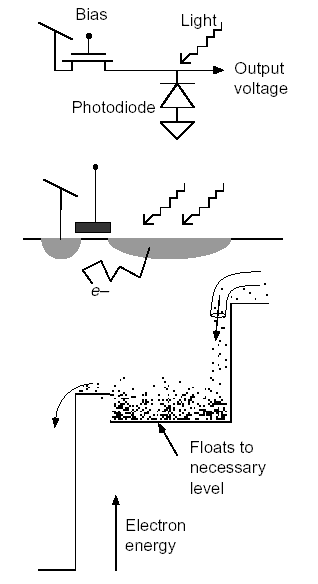
| Tobi Delbruck | |||||||||||
| Home | Wiki | Motivation | History | People | Projects | Publications | Resources | Fun | Contact | ||
Shot noise and thermal noise have long been believed to be the results of distinct mechanisms but they aren't. Thermal noise is shot noise due to internal diffusion currents in electronic devices. Shot noise is shot noise. The main result is illustrated in these measured and theoretical results for noise in subthreshold MOS transistors:


Readers could be left with a misconception from this paper if they do not understand it completely.
In considering the noise in a source follower output (in the paper a
simple source follower logarithmic photoreceptor), you might think that
the noise is doubled over what it really is. Consider a circuit to the
left. It consists of a photodiode and feedback transistor. The
photodiode contributes shot noise, and so does the source of the
feedback transistor. An electron appears at some random time in
the photodiode/source, and disappears sometime later. It is only the
length of time that electron is around that matters, not the independent
times it appears and disappears. You can explicitly compute the total
noise by computing dV^2/df and multiplying by the noise equivalent
bandwidth of the first order lowpass filter: In the source-follower
receptor you have (2qI + 2qI)*(1/g_s2)*(g_s/C)*(pi/2)*(1/(2*pi))
=kT/C. (Thanks to Rahul).
The total voltage noise, defined as mean square variation in voltage,
is exactly kT/C, not 2kT/C.
Rahul reviews the pros and cons of analog and digital computation. He proposes that computation that is most efficient in its use of resources is neither analog computation nor digital computation, but rather is an intimate mixture of the two forms. For maximum efficiency, the information and information-processing resources of the hybrid form must be distributed over many wires, with an optimal signal-to-noise ratio per wire. Our results suggest that it is likely that the brain computes in a hybrid fashion, and that an underappreciated and important reason for the efficiency of the human brain, which only consumes 12W, is the hybrid and distributed nature of its architecture.
| Home | Motivation | History | People | Projects | Publications | Resources | Fun | Contact |